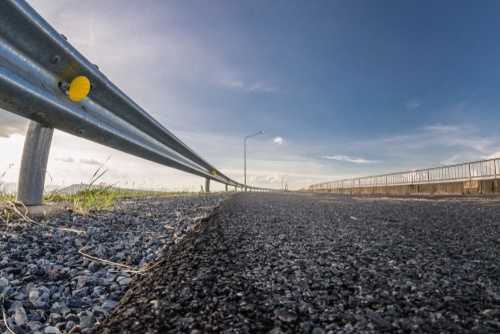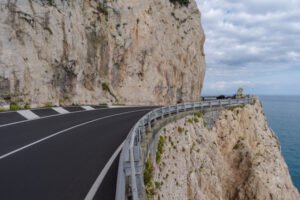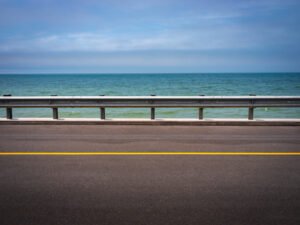
Guardrails on California highway are intended to save lives. However, poorly designed and defective guardrails can actually increase the risk of serious injury or death in an automobile collision.
Five key things to know about guardrail accident lawsuits in California are:
- Typical defendants are the construction company that made the defective guardrail and the government entity that owned it.
- Depending on the case, you can sue on negligence and/or strict product liability grounds.
- You may be able to recover medical expenses, lost income, and pain and suffering.
- If your family member was killed in the guardrail crash, you can file a wrongful death lawsuit to recover funeral expenses and lost income.
- The statute of limitations to sue the government is usually just a few months, so contact a personal injury attorney immediately to get started on your case.
Our California personal injury lawyers discuss the following frequently asked questions about guardrail injury and defective highway guardrail lawsuits:
- 1. What causes guardrail accidents?
- 2. Who is at fault?
- 3. How much can I sue for?
- 4. How long do I have to file?
If you have further questions about guardrail accidents after reading this article, we invite you to contact us at Shouse Law Group.
1. What causes guardrail accidents?
Guardrails are barriers that are intended to keep vehicles from going off the road or crossing over the median. Unfortunately, defective design and faulty construction mean highway guardrails can increase the risk of injury or fatality in car crashes in California.
Guardrail ends are generally intended to telescope upon impact. However, many guardrails do not telescope, and instead, the guardrail ends impale the vehicle.
Guardrail injuries can include:
- Broken bones,
- Glass injuries,
- Head injuries,
- Back injuries,
- Internal bleeding,
- Neck and spinal injuries,
- Paralysis,
- Catastrophic injuries,
- Burn injuries,
- Electrical injuries,
- Concussion,
- Loss of a limb, or
- Other severe injuries

Poorly designed and defective guardrails can increase the risk of a serious injury or death in a collision.
2. Who is at fault?
In a guardrail accident lawsuit California, the possible defendants could include:
- Local, state, or federal government,
- Construction company,
- Guardrail company / designer,
- Guardrail manufacturer,
- Guardrail distributor or vendor, or
- Individual employee.
As discussed below, liability in a guardrail injury accident can be based on one of the following causes of action:
- Product liability,
- Premises Liability, and/or
- Negligence.1
Defective guardrails
Under California product liability laws, a guardrail manufacturer, designer, seller, and distributor may all be strictly liable for defective guardrails. The legal grounds for a lawsuit may be based on:
Generally, you would need to prove in court:
- The defendant designed, sold, distributed, or manufactured a defective guardrail;
- The guardrail was defective when it left the defendants’ possession;
- The guardrail was used in a reasonably foreseeable way; and
- You suffered damage as a result of the defective guardrail.2
Examples
- One guardrail manufacturer has been subject to multiple lawsuits for changing the initial design of the guardrail, failing to disclose the changes, and making dimensional design changes that altered the original design to save the company $50,000 annually.3
- A study found the Trinity ET-Plus guardrail system design was nearly 3 to 4 times more likely to produce a fatality in guardrail crashes than the ET-2000 design.4
- In a jury trial, the company Trinity was determined to have had made false claims to the government when they altered their guardrail design, and awarded a whistleblower and the Federal Highway Administration (FHWA) $175 million in damages.5
- Another guardrail manufacturer may have provided defective guardrail instructions or failed to provide proper product warnings. According to the State of Tennessee Department of Transportation regarding the Lindsay Transportation Solutions X-Lite End Terminal:
“unclear instructions may have caused installation deficiencies, which could result in the terminal performing differently from the original test conditions.”6
Guardrails on government property
Most guardrail accidents in California occur on public highways or roadways owned by the state, local, or federal government. When there are known safety hazards on the road, the government may be responsible for fixing the problem or warning drivers about the safety issues.7
In California, if you are injured because of a known guardrail danger, you have to show:
- The guardrail created a dangerous condition at the time of the accident;
- Your injury was proximately caused or made worse by the guardrail;
- The guardrail created a reasonably foreseeable risk of the kind of injury that occurred; and
- The public entity had notice of the guardrail danger and had enough time to take measures to protect against the dangerous condition.8
Negligent guardrail installation
Even if the guardrail is designed and manufactured properly, taking shortcuts when installing these safety measures could increase the risk of harm to drivers. If an individual employee is negligent in installing the guardrails, the company may also be liable for the employee’s negligence.
An employer can be vicariously liable for the negligence of an employee when the employee was acting within the scope of their employment at the time the negligent act occurred.9

When a car crash is made worse due to a defective guardrail, you can sue the construction company and the government.
3. How much can I sue for?
Compensatory damages available after a guardrail accident lawsuit in California can include reimbursement for:
- Medical expenses,
- Surgery costs,
- The cost of continuing medical care,
- Loss of income when you cannot work,
- Loss of future income potential,
- Property damage,
- Compensation for the loss of a limb,
- Loss of consortium,
- Emotional damages, and
- Pain and suffering.
Many guardrail accidents end with fatal injuries. In these cases, surviving family members can claim such wrongful death damages can as:
- Funeral and burial expenses,
- Loss of financial support from the loss of a loved one, and
- Loss of companionship and guidance.10
4. How long do I have to file?
The statute of limitations for most personal injury and/or wrongful death lawsuits in California is 2 years.11
To file a lawsuit against the government, however, the deadline is only 6 months after the incident. Plus there is a notice requirement you have to comply with first.12

Guardrails are supposed to telescope upon impact to lessen collision damage.
Legal References:
- See, for example, California Civil Code section 1714(a) (“Everyone is responsible, not only for the result of his or her willful acts, but also for an injury occasioned to another by his or her want of ordinary care or skill in the management of his or her property or person.”). See also California Civil Jury Instructions (“CACI”) 400 – Negligence.
- See Soule v. GM Corp. (1994) 8 Cal.4th 548, 560 (“A manufacturer, distributor, or retailer is liable in tort if a defect in the manufacture or design of its product causes injury while the product is being used in a reasonably foreseeable way.”)
- See The Safety Institute’s response to Federal Highway Administration Review, Dec. 13, 2015.
- Same. (A case control study found Trinity Industries, Inc.’ ET-Plus design was almost twice as likely to produce an injury and almost 3 to 4 times more likely to produce a fatality than the ET-2000 design.)
- Same. See also Nate Raymond, U.S. top court declines to take up Trinity Industries guardrail case, Reuters (January 7, 2019)(“The justices left in place a 2017 decision by the New Orleans-based 5th U.S. Circuit Court of Appeals overturning a 2014 verdict by a federal jury in Texas that found Trinity had defrauded the government….Joshua Harman, a competitor of Dallas-based Trinity, filed the lawsuit in 2012 under the False Claims Act, which allows [whistleblower lawsuits] against companies on the government’s behalf to recover fraudulently paid-out taxpayer money.”).
- See Correspondence from State of Tennessee Department of Transportation Commissioner John C. Schroer at footnote 2 above.
- See, for example, California Civil Jury Instructions (CACI) (2017) 1000. Premises Liability. Essential Factual Elements. See also Sprecher v. Adamson Companies (1981) 30 Cal.3d 358. See, for example, California Government Code 835 — Liability of Public Entities.
- Same.
- Perez v. Van Groningen & Sons, Inc. (1986) 41 Cal.3d 962, 967 (“Under the doctrine of respondeat superior, an employer is vicariously liable for his employee’s torts committed within the scope of the employment.”). See California Civil Jury Instructions (CACI) 3701 — Tort Liability Asserted Against Principal–Essential Factual Elements. See also Lisa M. v. Henry Mayo Newhall Memorial Hospital (1995) 12 Cal.4th 291, 296–297 (“The rule of respondeat superior is familiar and simply stated: an employer is vicariously liable for the torts of its employees committed within the scope of the employment.“)
- California Code of Civil Procedure 377.60 (“A cause of action for the death of a person caused by the wrongful act or neglect of another may be asserted by any of the following persons or by the decedent’s personal representative on their behalf: (a) The decedent’s surviving spouse, domestic partner, children, and issue of deceased children, or, if there is no surviving issue of the decedent, the persons, including the surviving spouse or domestic partner, who would be entitled to the property of the decedent by intestate succession.”)
- California Code of Civil Procedure §335.1.
- See CCP § 341.
